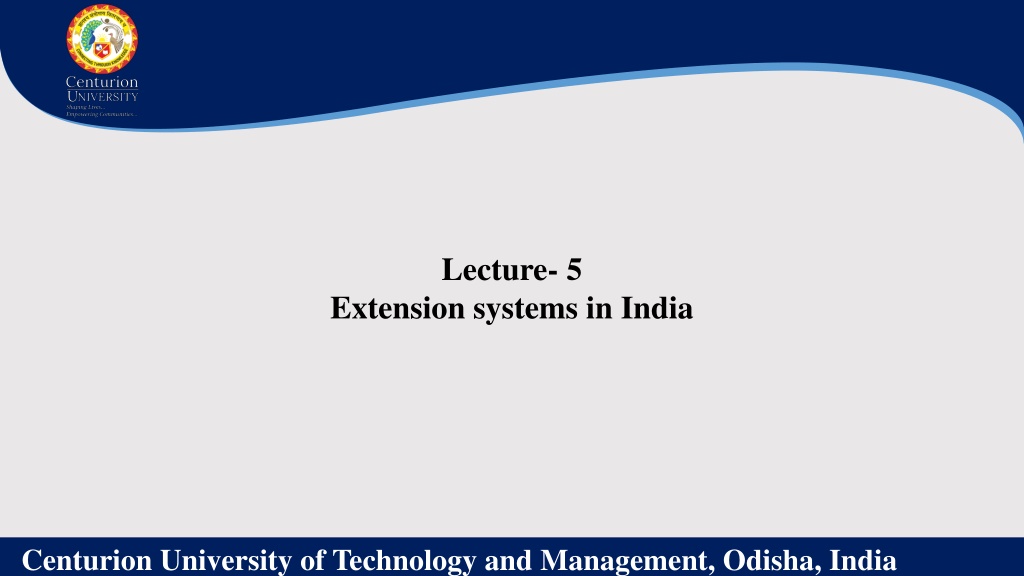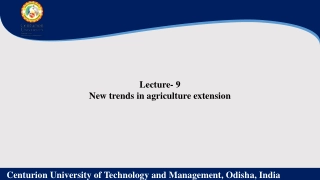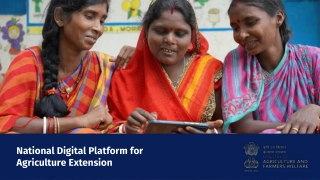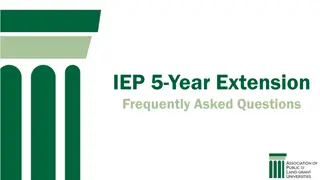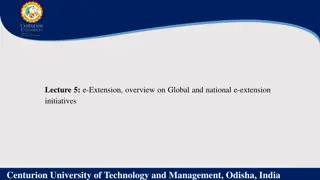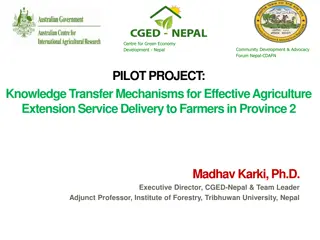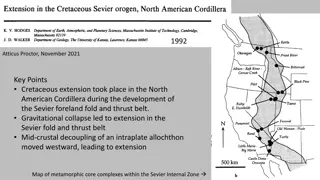Lecture- 5. Extension systems in India
Explore the evolution and impact of agricultural extension systems in India, including initiatives like the National Agricultural Technology Project (NATP), Agriculture Technology Management Agency (ATMA), and the National Mission on Agriculture Extension and Technology (NMAET). These programs aim to improve technology dissemination, enhance farmer engagement, and address key national agricultural objectives through a demand-driven approach. Learn how these schemes are shaping the future of agricultural development in the country.
Download Presentation

Please find below an Image/Link to download the presentation.
The content on the website is provided AS IS for your information and personal use only. It may not be sold, licensed, or shared on other websites without obtaining consent from the author. Download presentation by click this link. If you encounter any issues during the download, it is possible that the publisher has removed the file from their server.
E N D
Presentation Transcript
Lecture- 5 Extension systems in India Centurion University of Technology and Management, Odisha, India
Agriculture Extension Services by the Public Sector- 1. Agriculture Technology Management Agency 2. NATP 3. National Mission on Agriculture Extension and Technology Public Agriculture Extension system- 1. Krishi Vigyan Kendras 2. State Agricultural Universities 3. ICT-led Extension 4. Agriculture Clinic and Agriculture Business Centre Centurion University of Technology and Management, Odisha, India
NATIONAL AGRICULTURAL TECHNOLOGY PROJECT (NATP) Introduced in the financial year 1995-96. Govt. of India approved this project in November 1998 for full- scale implementation. Objectives of NATP: address key constraints improve the relevance of technology Conservation of natural resources address key national objectives. Increase the quality and type of technologies Enable research and extension systems to become demand driven. Strengthen research-extension-farmers (R-E-F) linkages. Centurion University of Technology and Management, Odisha, India
National Mission on Agriculture Extension and Technology (NMAET): The feedback on the performance of ATMA through various evaluation studies and the observations of the working group on extension set up by the Planning Commission to prepare for the Twelfth Five ear Plan paved the way a comprehensive new national scheme to address extension services. The National Mission on Agriculture Extension and Technology (NMAET) was launched by the Department of Agriculture and Farmers' elfare (DACF) in 2014-15 and takes a holistic view of extension by embedding components for technical support and training in four major sub-schemes. Sub Mission on Agricultural Extension (SMAE) n Sub-Mission on Seed and Planting Material (SMSP) Sub Mission on Agricultural Mechanization (SMAM)) Centurion University of Technology and Management, Odisha, India
Agriculture Technology Management Agency (ATMA) In 1998, the Indian Government, with the support of orld Bank, introduced the Agriculture Technology Management Agency (ATMA) under the Innovation in Technology Dissemination (ITD) component of the National Agricultural Technology Project (NATP). It was first introduced in 28 districts in seven states from 1998 to 2003 under the guidance of MANAGE (National Institute of Agricultural Extension Management), an institution promoted by Ministry of Agriculture, Government of India. It was later expanded throughout the country in 2005. Goals of ATMA: Decentralize decision-making to the district level Increase farmer input into programme planning Increase programme coordination and integration Centurion University of Technology and Management, Odisha, India
ATMA Governing Board Chairman: District Magistrate/Collector Vice-Chairman: Chief Executive Officer (CEO)/Chief Development Officer (CDO) Members: Joint Director/Deputy Director (Agriculture) A representative from KVK, One farmer representative, One livestock producer, One horticulture farmer, Representative of Women Farmers Interest Group, One SC/ST farmer representative, A representative of NGO, Lead Bank Officer of the district, A representative of District Industrial Centre Sub-divisional Agricultural Officers nominated as members. On the basis of local requirement other members may be nominated. Centurion University of Technology and Management, Odisha, India
Key functions of ATMA Governing Board Review and approve Strategic Research and Extension Plan (SREP) Receive and review annual reports Receive and allocate project funds ATMA management Committee: Chairman: Project Director of ATMA Members: District Heads of Departments of Agriculture, Horticulture, Animal Husbandry, Fisheries Sub divisional Agricultural Officers, One representative of NGO in-charge of farmers organization, Two representative of farmers organizations (one year rotation basis) Centurion University of Technology and Management, Odisha, India
Advantages ATMA is more effective in technology generation. ATMA ensures a greater coordination among sister departments, it helps in better management Participation is the basic principle of ATMA. women empowerment. ATMA seeks a greater linkage with research and extension. ATMA provides a single window extension system by creating FIAC at the block level. Farmer can get any advice and suggestions from there only. ATMA has an effective feedback mechanism. Centurion University of Technology and Management, Odisha, India
Krishi Vigyan Kendras (KVK)- These are the field research units of the national agricultural research system (the Indian Council for Agricultural Research-ICAR) and are meant to test new seed varieties, agronomic practices, machinery etc. in field conditions across different agro-climatic zones before these are cleared for adoption by farmers. The KVK initiative was launched in 1974 and has grown into 611 centres by the end of 2011, ensuring at least one KVK in each district of the country. State Agricultural Universities- The State Agricultural Universities (SAU) are another important arm for promoting extension activities in the States. hile their main mandate is formal degree programmes in major agricultural disciplines, they provide extension and training support through the directorate of extension and education. Centurion University of Technology and Management, Odisha, India
An important reform undertaken in recent years by the Ministry of Agriculture at the national level has been the increasing use of modern technologies and communication strategies to help educate farmers. ICT has significant potential to reach large numbers of farmers in a cost-effective manner. It can also facilitate two way information flows between farmers and the extension agencies- Farmers Portal m-kisan kisan Call Centre Centurion University of Technology and Management, Odisha, India
